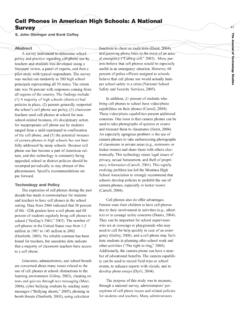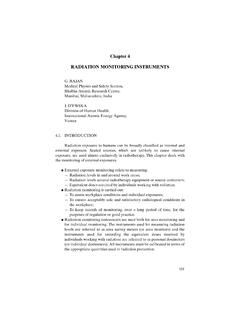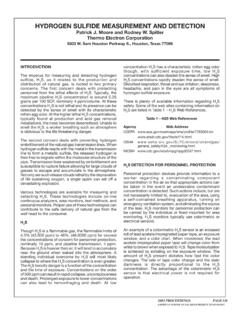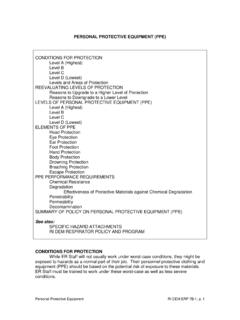Transcription of How Accurate are Phosphine Monitoring Devices?
1 Volume 7 Journal of Pesticide Safety Education 2005 Page 1 How Accurate are Phosphine Monitoring devices ? Ronda Danley, former Graduate Research Assistant, Oklahoma State University, Stillwater, OK, Brian D. Adam, Professor, Oklahoma State University, Stillwater, OK, Jim Criswell, Pesticide Coordinator, Oklahoma State University, Stillwater, OK, Ronald Noyes, Professor Emeritus, Oklahoma State University, Stillwater, OK, Thomas W. Phillips, Professor, Oklahoma State University, Stillwater, OK, Abstract A critical component of worker safety for fumigators Monitoring Phosphine gas levels is an Accurate Monitoring device. Researchers evaluated accuracy levels of four electronic devices and a tube-type device while Monitoring Oklahoma grain elevators under fumigation; particular attention was paid to accuracy levels in the dangerous range.
2 Average accuracy of the electronic devices ranged from 60% to 100%. Although the tube-type device was technically the most Accurate , in practice it may be less Accurate due to operator error in reading the tubes. It is important for safety educators to fully understand the benefits and limitations of Phosphine Monitoring devices . Keywords: Phosphine fumigation monitors, grain storage Introduction The Environmental Protection Agency (EPA) mandated a review of phosphide fumigants in response to reports of human poisonings by Phosphine gas inhalation (Initiation of aluminum and magnesium phosphide stakeholder process, 1998; Amendment to Reregistration Eligibility Decision for aluminum and magnesium phosphide, 2001). The review prompted new restrictions on the use of Phosphine . The revised Phosphine labels have incorporated several of the Risk Mitigation Measures (RMMs) proposed by EPA during the review, particularly those focused on safety of both fumigators and bystanders (Degesch America, 2004).
3 To help fumigators prevent injuries from Phosphine use, EPA requires that workers monitor gas levels in order to determine that a safe threshold level has been reached before they enter a structure under fumigation. If monitors indicate that gas levels are above the threshold limit value (TLV) for human safety ( ppm) then workers are required to use specified personal protective equipment or wait to enter the facility until gas levels have subsided below the TLV. Two types of Phosphine gas Monitoring devices are currently available, the electronic type and the tube type. Electronic monitors utilize an electrochemical sensor in which a change in current across the sensor, directly proportional to Phosphine concentration, is recorded as the sensor interacts with the target gas. Tube-type devices are graduated clear glass tubes, approximately 10 x cm, which are filled with a specialized white reactive powder that changes color along the length of the tube in direct proportion to the concentration of Phosphine gas that is drawn through the tube.
4 2004 Danley et al: How Accurate Are Phosphine Monitoring devices ? Page 2 In choosing a Monitoring device, cost as well as functional features ( ease of use, ruggedness, and accuracy) are important factors to consider. Initial purchase price of the four electronic devices tested in this study ranged from $779 to $1,810 while the tube-type device cost $215. Electronic devices can be used multiple times. The tube-type device requires a single-use tube at each reading so cost increases with the number of readings. A cost analysis was performed in which initial equipment costs were amortized over a five-year use period, and annual equipment costs for each device were added to annual costs of single-use tubes for the tube-type device and annual recalibration costs for the electronic devices . Yearly cost of the tube-type device is less than that for the electronic devices if fewer than 50 readings are taken, but higher if more than 50 readings are taken.
5 Additional details are provided in Danley (2002) and Danley et al. (2004). Determining accuracy levels of both electronic and tube-type Phosphine Monitoring devices was the focus of this study; most important was the determination of whether the devices reliably detect dangerous concentrations of Phosphine gas. The intent of this study is not to endorse one monitor over another but to highlight the importance of teaching fumigators about the limitations of monitors and of reinforcing proper training and use of Phosphine testing equipment. Four electronic devices and one tube-type device were selected by University researchers for a 31-day Monitoring study of Phosphine gas levels in Oklahoma grain elevators under fumigation. While under these typical field conditions, the accuracy of the devices was measured in a University laboratory 16 times (approximately every other day) to determine the extent to which accuracy of each device drifted over time.
6 Procedures Manufacturers of electronic monitors instruct users to periodically return the devices for calibration. In replicating normal use patterns, the electronic devices used in this study were factory-calibrated prior to study initiation. Laboratory Readings for Electronic Monitors During the 31-day study the devices were used in actual field conditions. Approximately every other day, or 16 times during the study, the devices were calibrated in the laboratory to determine their accuracy. Calibration was performed using an authentic quantitative standard of hydrogen phosphide gas in nitrogen and the following procedures. Three (Monitors #1, #2, and #4) of the four electronic monitors were placed in 3, ml glass jars and sealed. The devices were then placed under a laboratory hood. Ten ml of air were removed with a syringe and 10 ml of Phosphine gas at 189 ppm in nitrogen were then syringed back into the jar to achieve a Phosphine gas concentration of approximately ppm.
7 The true concentration was verified with a gas chromatograph using methods reported by Phillips et al. (1999). The study focused on accurately detecting low concentrations near the TLV for safety purposes, rather than the higher concentrations used in Monitoring for fumigation effectiveness. Since monitor #3 was larger than the Page 3 Journal of Pesticide Safety Education Volume 7 glass jar, its wand, rather than the whole device, was inserted into the jar septum after the Phosphine gas was syringed in. In each case, after sample addition, gas readings were taken every fifteen seconds until monitor readings of the gas level stabilized. A reading was considered stabilized after showing the same concentration for one minute without change. Accuracy was computed by first subtracting the stabilized reading from the standard ( ppm), then dividing the result by ppm, and then multiplying by 100 to give the percent error.
8 For example, if the monitor reading was ppm, the error factor would be 20%, resulting in an overall accuracy level of 80%. If the monitor reading was lower than ppm (the TLV), the accuracy would be less than 60%. Accuracy rates in this range give false 'safe' readings and thus can endanger the applicator. The length of time needed before readings stabilize, or time to stabilization, for an individual monitor was also recorded. This important measurement tells workers how long they must remain exposed to potentially high Phosphine levels before they obtain a proper reading on the device. Since Monitoring must be completed before workers know whether the workplace is safe to enter, workers should wear at least a self-contained respirator while Monitoring inside a structure, or, monitor the atmosphere from outside the structure until determining that gas levels are at or lower than the TLV.
9 It is important to recognize that these measurements were taken under laboratory conditions where gas level was constant; gas levels fluctuate in a field situation. Reading Accuracy of Tube-Type Monitoring Device The tube-type Monitoring device was tested for accuracy using two techniques. The first test was of the reactive powder, in which air from a sample jar containing ppm Phosphine was drawn into the tube, similar to tests performed on the electronic monitors. The second technique tested the user's ability to accurately read this device. Although the electronic-type devices provide a digital display of the gas reading, users must read tube-type monitors by determining to what graduation on the tube the color change had progressed, much like one would read a mercury thermometer. Thus, data collectors might not read the numbers consistently.
10 In this study 28 Oklahoma grain elevator operators, who participated in a University-sponsored Phosphine fumigation-training workshop, were instructed in the use of the devices . Each operator was then given the same set of five tubes that had been exposed to different lab-determined levels of Phosphine gas (4 ml, 8 ml, and 30 ml of gas, for concentrations of , , and ppm respectively). To maximize color contrast so that the gradations could be more easily read, the five tubes were attached to pieces of white paper. The elevator operators were asked to record their readings of the gas levels indicated in each tube. The true gas concentrations and the elevator operator readings were compared with one another to obtain measurements of operator reading accuracy. 2004 Danley et al: How Accurate Are Phosphine Monitoring devices ?



















